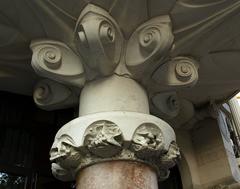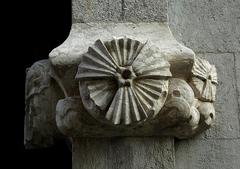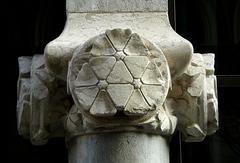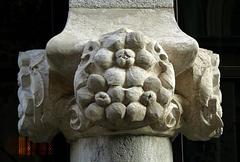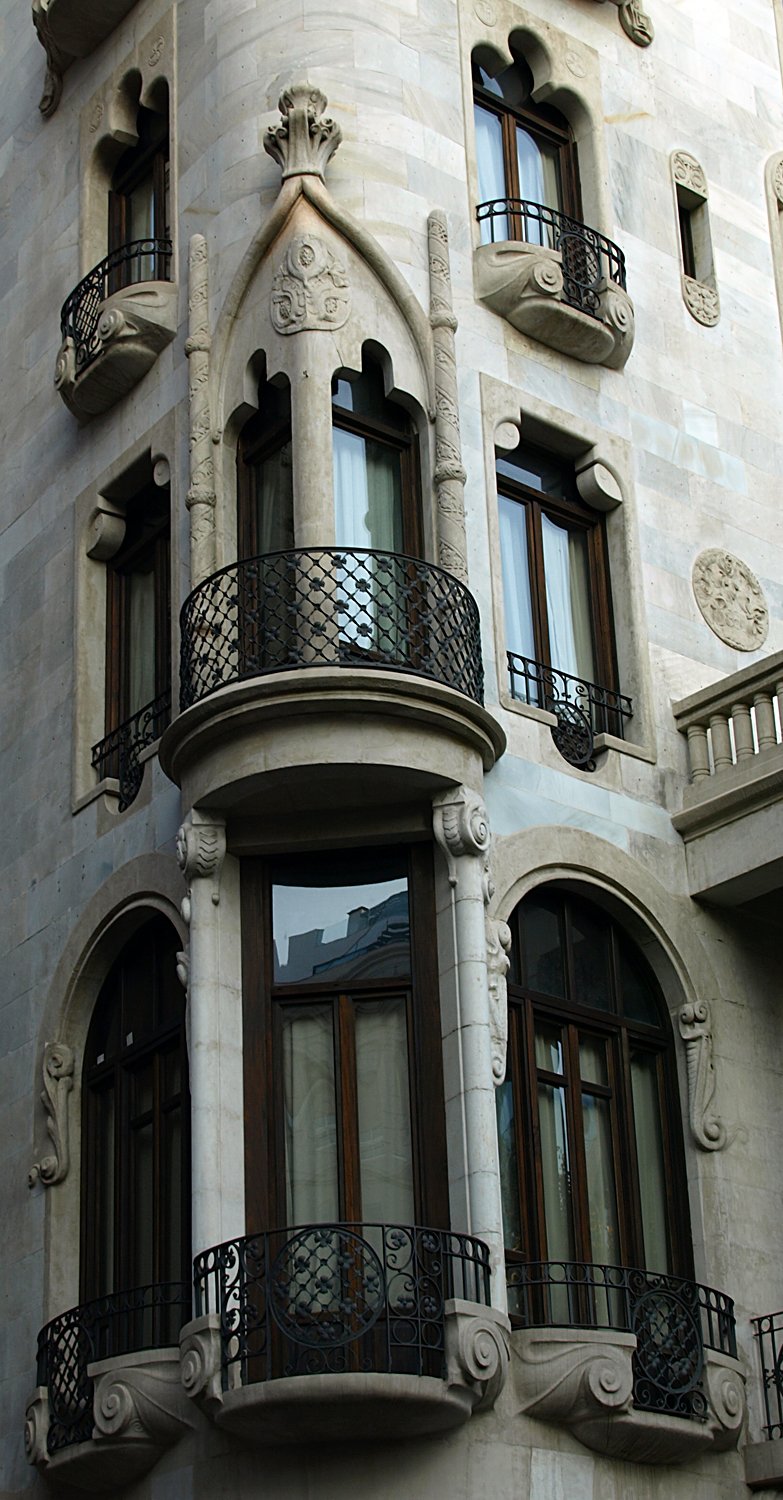
Casa Fuster Barcelona: Visiting Hours, Tickets, and Visitor Guide
Date: 14/06/2025
Introduction
Casa Fuster stands as one of Barcelona’s most celebrated Modernist landmarks, blending architectural grandeur with vibrant cultural life. Located at the prestigious upper end of Passeig de Gràcia, this masterpiece by Lluís Domènech i Montaner encapsulates the spirit of early 20th-century Catalonia and continues to serve as a symbol of both the city’s artistic innovation and its enduring social vitality. Today, Casa Fuster functions as a luxury hotel, cultural hub, and living monument to Barcelona’s dynamic past and present (Hotel Casa Fuster History; Barcelonaturisme).
Table of Contents
- Historical Background
- Architectural Significance
- Visitor Information
- Dining and Events
- Nearby Attractions
- Frequently Asked Questions (FAQ)
- Travel Tips & Summary
- References
Historical Background
Origins and Construction
Casa Fuster was commissioned in 1908 by Mariano Fuster i Fuster as an opulent gift for his wife, Consol Fabra, daughter of the Marquis of Alella. The celebrated architect Lluís Domènech i Montaner, with his son Pere, designed the building at the junction of Passeig de Gràcia and Avinguda Diagonal. The site, formerly a chocolate factory, was chosen for its prominence in Barcelona’s rapidly expanding Eixample district (Arquitectura Catalana; Wikipedia).
Construction began in 1908 and concluded in 1911. The use of white marble for the façade, a rarity at the time, made Casa Fuster one of the most expensive private residences in Barcelona, reflecting both the owner’s affluence and the Modernisme movement’s celebration of craftsmanship (Johansens).
Social and Cultural Hub
Initially, the Fuster family occupied the main floor, with Casa Fuster quickly becoming a symbol of Barcelona’s elite society. In the 1920s, the building changed hands, and Café Vienés on the ground floor became a fashionable meeting spot for artists and intellectuals, continuing its role as a cultural salon (Hotel Casa Fuster History; Johansens).
Threats and Preservation
In the 1960s, plans to demolish Casa Fuster for a modern office tower provoked public outcry. Thanks to a strong preservation movement, the building was saved and underwent restoration, serving various roles until its transformation into a luxury hotel in 2004 (SHBarcelona).
Architectural Significance
Exterior: Modernisme Meets Neo-Gothic
Casa Fuster’s façade is a harmonious blend of white marble, glass, and Montjuïc stone, adorned with pink stone columns, trilobate windows, and sculptural floral motifs. The cylindrical turret at the corner adds a dynamic visual anchor, softened by glass galleries and delicate ironwork (Barcelonaturisme; Tour in Barcelona).
The building’s design integrates organic forms, natural light-filled courtyards, and French-style mansard roofs, distinguishing it from neighboring Modernist icons like Casa Milà and Casa Batlló (Arquitectura Catalana).
Interior: Grand Spaces and Artistic Details
Inside, Casa Fuster retains its modernist spirit through lofty ceilings, ornate columns, and period furnishings. Key spaces include:
- Café Vienés: A renowned gathering place for cultural events and Thursday jazz nights.
- Blue View Mirador Terrace: Rooftop terrace with panoramic city views, a pool, and a cocktail bar (TripVenture).
- Reading Room: A tranquil space reflecting the building’s intellectual legacy.
Original decorative elements, such as floral reliefs and the “C.F.” monogram, highlight the building’s personal and artistic history (Barcelonaturisme).
Structural Innovation
Casa Fuster was pioneering in its use of reinforced concrete, enabling flexible, open interior layouts and large windows—a testament to Domènech i Montaner’s architectural ingenuity (Breaking through History).
Visitor Information
Location & Accessibility
- Address: Passeig de Gràcia, 132, 08008 Barcelona, Spain (Casa Fuster Official Site)
- Metro: Provença-Diagonal (Lines L3, L5); Passeig de Gràcia (L2, L3, L4)
- Bus: Multiple lines stop nearby
- Airport: Barcelona-El Prat (23-minute drive; shuttle and taxi services available)
Visiting Hours & Tickets
- Hotel & Lobby: Open 24/7 for guests
- Public Areas (Lobby, Restaurant): Free entry, generally open daily from late morning until midnight
- Rooftop Terrace & Bar: Open late morning to midnight; may have a cover charge during special events
- Guided Tours: Available by appointment; typically €15 for non-guests; check official website for current schedules
- Accessibility: Step-free entrances, elevators, and adapted rooms for guests with disabilities
Accommodation & Facilities
- Rooms: 105 luxury rooms and suites, with city or Passeig de Gràcia views, modern amenities, and elegant décor
- Facilities: Rooftop swimming pool, fitness club, sauna, conference/event spaces, family-friendly amenities
- Wi-Fi: Complimentary throughout the hotel
- Parking: Available for a fee, advance reservation recommended
- Pets: Allowed, confirm in advance
Dining and Events
- El Panot Restaurant: Elegant dining with Catalan and Mediterranean cuisine, available in the main dining room or terrace
- Rooftop Bar: Offers cocktails, wines, and light bites with panoramic views; popular for sunset drinks and social gatherings
- Café Vienés Jazz Nights: Weekly live music events, open to both guests and the public, requiring advance booking for special nights (Casa Fuster Official Site)
Nearby Attractions
- Casa Milà (La Pedrera): 10-minute walk
- Casa Batlló: 8 minutes on foot
- Sagrada Família: 1.7 km away, accessible by metro or taxi
- Passeig de Gràcia: Premier shopping boulevard
- Gràcia Neighborhood: Boutique shops, local cafés, vibrant plazas
Frequently Asked Questions (FAQ)
Q: Do I need tickets to visit Casa Fuster?
A: No tickets are required for public areas; guided tours and special events may require advance booking and a fee.
Q: What are the visiting hours?
A: The hotel is open 24/7. Public areas are generally open daily from late morning until midnight; rooftop bar hours may vary, especially during events.
Q: Is Casa Fuster wheelchair accessible?
A: Yes, there are step-free entrances, elevators, and adapted rooms.
Q: Can non-guests access the rooftop pool?
A: The rooftop pool is reserved for hotel guests.
Q: Are pets allowed?
A: Yes, but confirm policies with the hotel in advance.
Q: Are there guided tours?
A: Yes, guided tours focusing on architecture and history are available by appointment; check the official website for details.
Travel Tips & Summary
- Book early for rooms or special events, especially during peak tourist seasons.
- Visit the rooftop terrace at sunset for the best views of Barcelona.
- Enjoy a jazz night at Café Vienés for a truly local experience.
- Consult the concierge for personalized recommendations and event bookings.
- Explore nearby Modernist landmarks for a fuller appreciation of Barcelona’s architectural heritage.
Casa Fuster is not just a striking example of Modernisme but a living cultural institution, hosting events, exhibitions, and gatherings that keep its artistic spirit alive. Its careful restoration and adaptive reuse set a benchmark for preserving historic sites while making them accessible and relevant today.
References
- Hotel Casa Fuster History
- Casa Fuster Wikipedia
- Arquitectura Catalana
- SHBarcelona
- Johansens
- Barcelonaturisme
- Breaking through History
- Tour in Barcelona
- TripVenture
- Itinerartis
- MyPremiumEurope
- Casa Fuster Official Site

